Windows Terminal is an open-source terminal application that allows you to access various command-line tools and shells such as PowerShell, CMD, and Windows Subsystem for Linux (WSL), and other custom shells.
It comes with useful features including multiple tabs, panes, Unicode and UTF-8 character support, a GPU accelerated text rendering engine, clickable URLs, graphical settings interface, and customizable themes, text, colors, backgrounds, and shortcut key bindings.
From Windows 10 version 1903, Microsoft started rolling out Windows Terminal as an inbuilt application, which means it will be automatically installed with the OS. If you don’t have Windows Terminal already installed, you can download and install it from the Microsoft Store or the GitHub releases page, or the official Microsoft Website.
List of all Windows Terminal Keyboard Shortcut keys
When you are using command-line tools like Windows Terminal, you would primarily use the keyboard to type and execute commands. So whenever you move your hand away from the keyboard to use the mouse to perform an action, it is a waste of time. Fortunately, Windows Terminals offers several Keyboard shortcuts/hotkeys for all important tasks like opening a new tab, switching between tabs, switch to/from full-screen mode, etc.
Instead of searching for Windows Terminal in the Windows search bar every time you want to launch it, you can pin it to the Taskbar. Then, you can simply click on the Windows Terminal icon from the taskbar or you can use the Windows + number keyboard shortcut to open it.
For instance, if you have Google Chrome, File Explorer, Word, and Windows Terminal from left to right on your taskbar, then you can use Windows + 4 to quickly open Windows Terminal, minimize it, or view it if it’s already open. The number 4 is the position of the app on the taskbar. Likewise, Windows + 1 would launch Google Chrome and Windows + 2 would launch File Explorer, and Windows + 3 would open MS Word.
Now let’s see the list of most useful Windows Terminal keyboard shortcuts you should know.
| ACTION | sHORTCUT KEYS |
|---|---|
| Open a new Windows Terminal instance. | Ctrl + Shift + N |
| Open a new default profile tab | Ctrl + Shift + T |
| Open a new tab, profile index: 1 to 9 | Ctrl + Shift + Number(1-9) |
| Switch to tab 1 to 9 | Ctrl + Alt + Number(1-9) |
| Switch to the Next tab | Ctrl + Tab |
| Switch to the Previous tab | Ctrl + Shift + Tab |
| Open the profile selection dropdown menu | Ctrl + Shift + Space |
| Open another instance of the current tab. | Ctrl + Shift + D |
| Open another instance of the current pane. | Alt + Shift + D |
| Close the current tab | Ctrl + Shift + W |
| Copy the selected text/command | Ctrl + C |
| Paste the selected text/command | Ctrl + V |
| Open Windows Terminal Settings UI | Ctrl + , |
| Open default settings file | Ctrl + Alt + , |
| Open settings file | Ctrl + Shift + , |
| Find | Ctrl + Shift + F |
| Create/Split a Vertical pane | Alt + Shift + + |
| Create/Split a Horizontal pane | Alt + Shift + - |
| Resize the current pane up | Alt + Shift + ↑ |
| Resize the current pane down | Alt + Shift + ↓ |
| Resize the current pane left | Alt + Shift + ← |
| Resize the current pane right | Alt + Shift + → |
| Open command palette | Ctrl + Shift + P |
| Increase the font size | Ctrl + = |
| Decrease the font size | Ctrl + - |
| Reset the font size to the default | Ctrl + 0 |
| Scroll up in the Windows Terminal. | Ctrl + Shift + ↑ |
| Scroll down in the Windows Terminal. | Ctrl + Shift + ↓ |
| Scroll up one page | Ctrl + Shift + PgUp |
| Scroll down one page | Ctrl + Shift + PgDn |
| Scroll to the top of history | Ctrl + Shift + Home |
| Scroll to the bottom of history | Ctrl + Shift + End |
| Move focus to one pane up | Alt + ↑ |
| Move focus to one pane down | Alt + ↓ |
| Move focus to one pane left | Alt + ← |
| Move focus to one pane right | Alt + → |
| Move focus to the last used pane | Ctrl + Alt + ← |
| Toggle on/off High Visibility screen mode. | Left Alt + Left Shift + PrtScn |
| Summon Quake mode | Win + ` |
| Toggle on/off fullscreen mode | F11 |
| Close the Windows Terminal (entire program) | Alt + F4 |
How to Customize and Change Windows Terminal Keybaord Shortcuts
As we mentioned before, Windows Terminal is an open-source application, you customize it however you want, which includes the keyboard shortcut keys (Key bindings). You can add new hotkeys and customize all the pre-existing hotkeys in the Windows Terminal by editing the ‘settings.json’ file.
settings.json file is the main configuration file that contains VS code settings and other configuration information of the Windows Terminal application. It can be easily modified to suit your needs. You can modify any key binding/shortcuts through the ‘actions’ property (formerly keybindings) in the ‘settings.json’ file.
Windows Terminal has two JSON file that holds settings for the application. One is ‘defaults.json’ which you cannot edit/modify, but you can use it as a reference to know the default configuration. And the other is ‘settings.json’ which you can edit to customize the app.
To access the ‘settings.json’ file, click the drop-down menu next to the plus (+) button at the top of the Windows Terminal window, and select ‘Settings’.
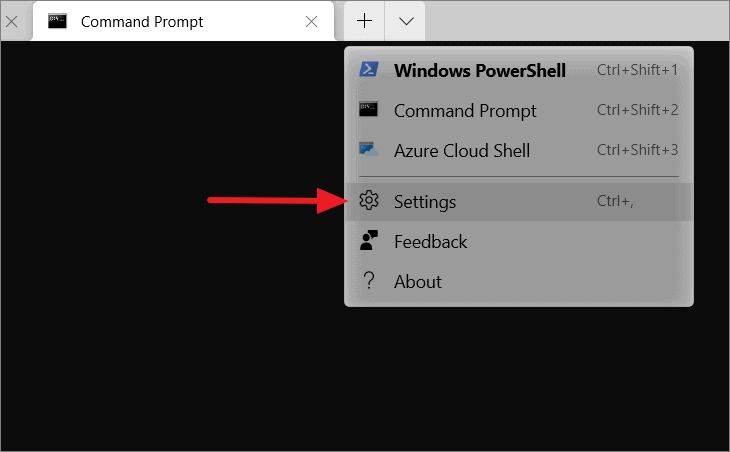
Then, click the ‘Open JSON file’ option at the bottom of the left-side navigation bar.

If this is the first time you’re opening a JSON file, it will ask you ‘How do you want to open this file?’ (With which app). You can open and edit JSON files in any text editor. So, select the ‘More apps ↓’ option to choose your text editor.
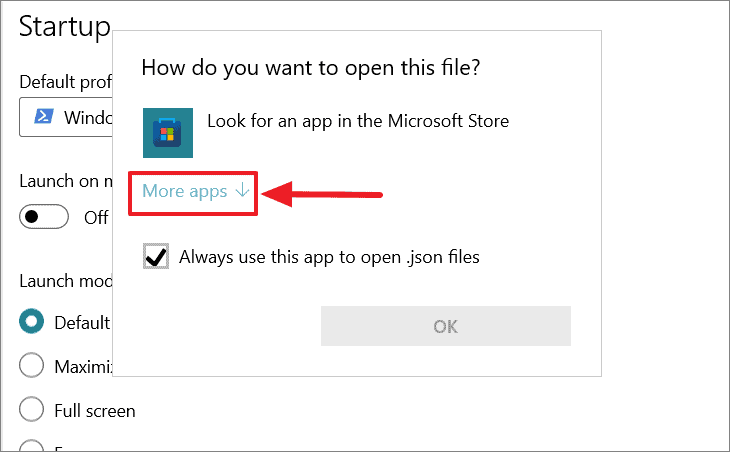
Then scroll down, select a text editor (the inbuilt Notepad works fine), and click ‘OK’. You can also check the ‘Alway use this app to open .json files’ box to make this app the default app for JSON files.
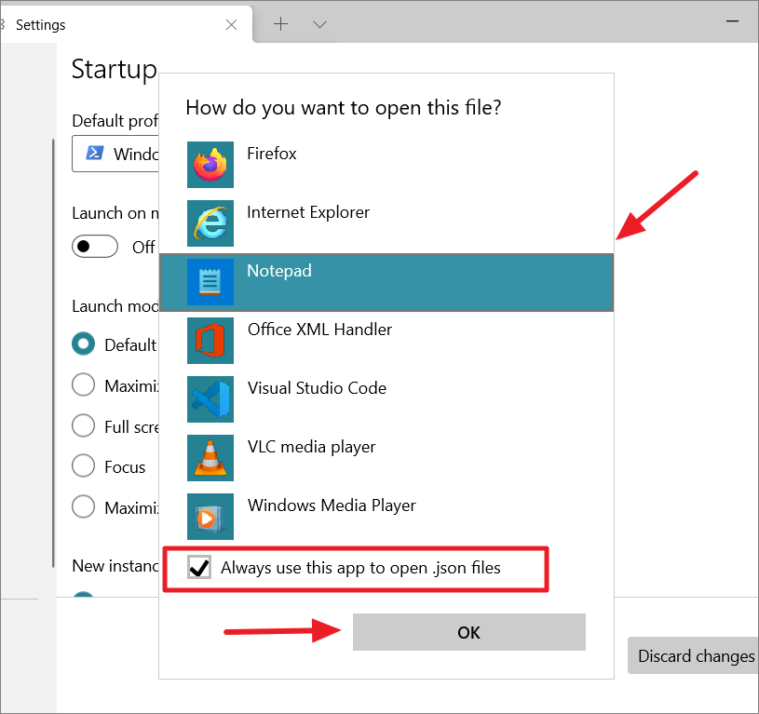
This will open the settings.json file in the Notepad.
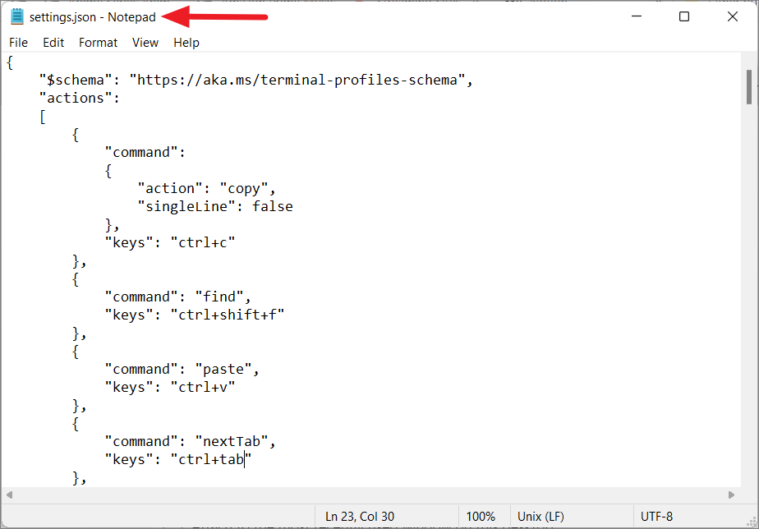
If you want to open the ‘default.json’ file to use it as a reference for the default settings, just click the ‘Open JSON file’ option while holding the Alt key.

Remember ‘defaut.json’ file is not intended for user manipulation, it can only be used for reference.
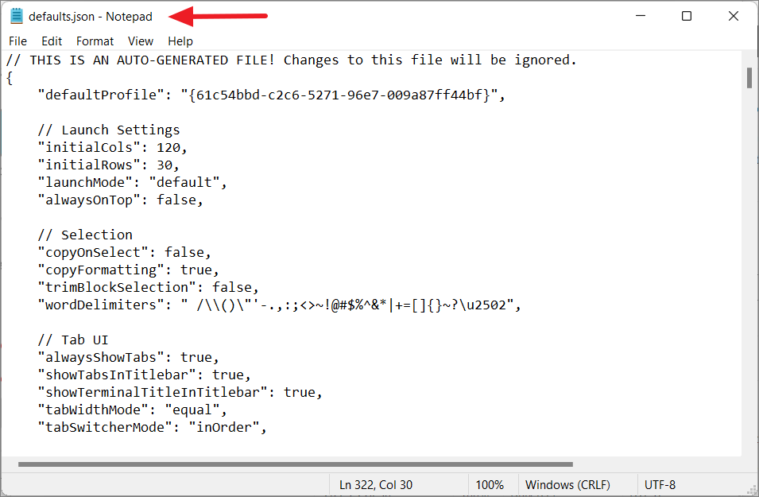
In the ‘settings.json’, you would probably see only a few key bindings objects under the ‘action’ (formerly, key bindings) property. It is because most of the key bindings are only stored on the ‘default.json file’.
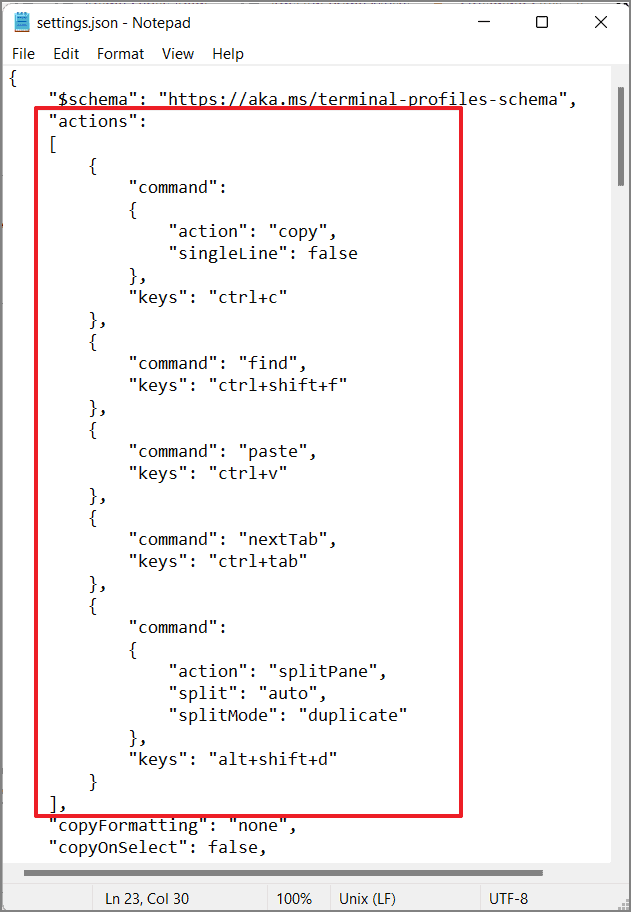
If you go through the ‘defaults.json’ file, you will find all the default key binding objects grouped into several categories under the ‘actions’ array.

If a certain shortcut key/hotkey is not convenient to you and you want to change it or you want to add a new hotkey for an action, then you can copy the relevant key binding object from the ‘defaults.json’ file to the ‘settings.json’ file and change the keys property in the object. Each key binding object has a ‘command’ value (which is a string) and a ‘keys’ value (which is the combination of shortcut texts).
For example, if you want to modify the hotkeys for ‘closing the current pane’ to Ctrl+Shift+X instead of the default Ctrl+Shift+W, then just replace the default shortcut keys with your shortcut. To do that, here we are copying the ‘closepane’ object from the ‘default.json’ file.
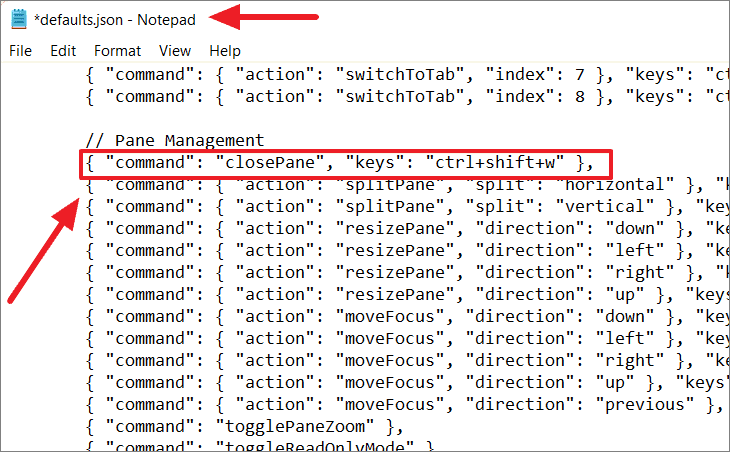
And pasting that object under the ‘action’ property of the ‘settings.json’ file. Then, replacing the shortcut key (Keys value) Ctrl+Shift+W with Ctrl+Shift+X as shown below.
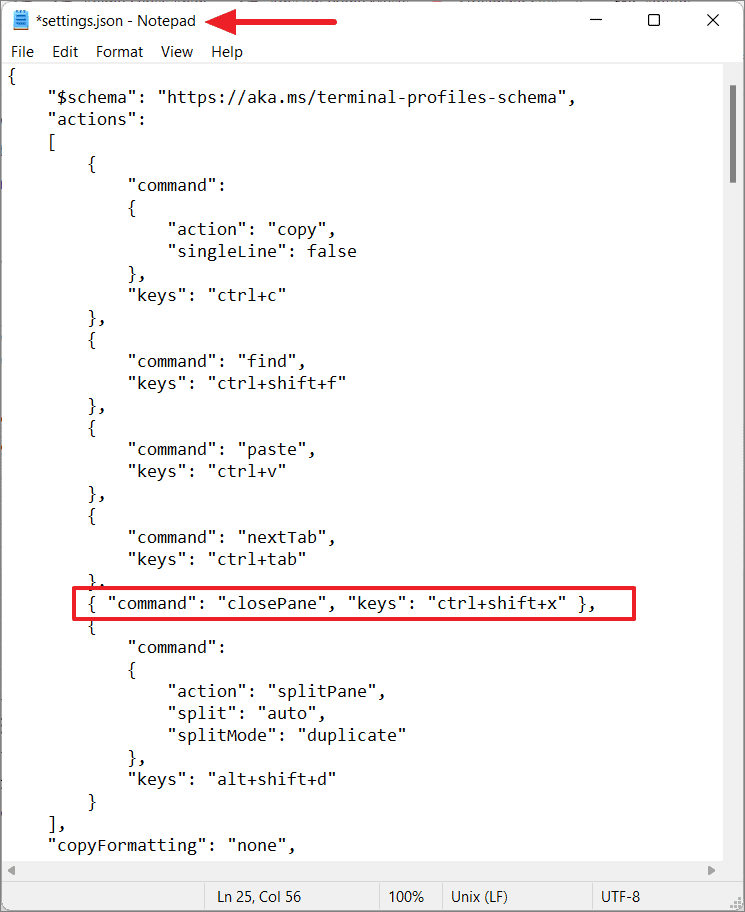
Don’t try to change anything else in the key bindings objects, only change the shortcut text.
After changing the shortcut, click ‘File’ and select ‘Save’ or press Ctrl + S to save the changes.
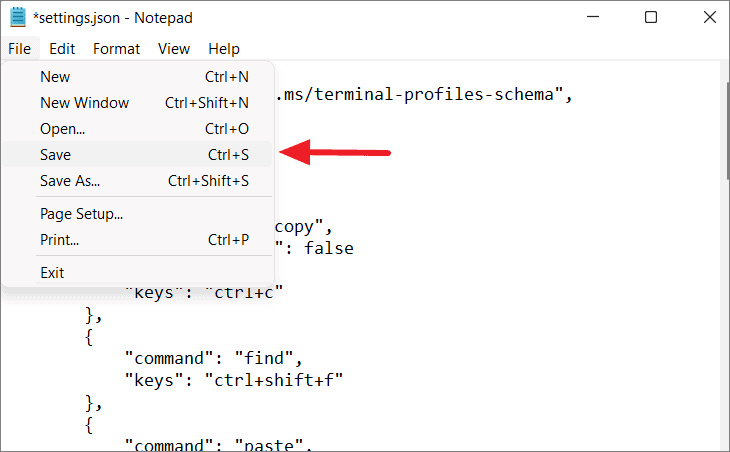
You can use this same method to add new shortcut keys. Also when you are changing shortcut text, make sure it doesn’t conflict with other shortcut keys in the file.
That’s all the shortcuts keys you should know in Windows Terminal.


